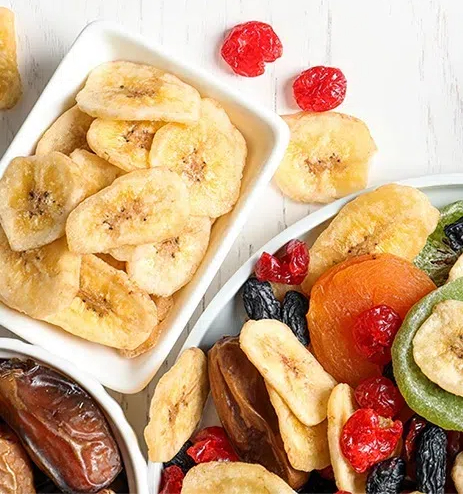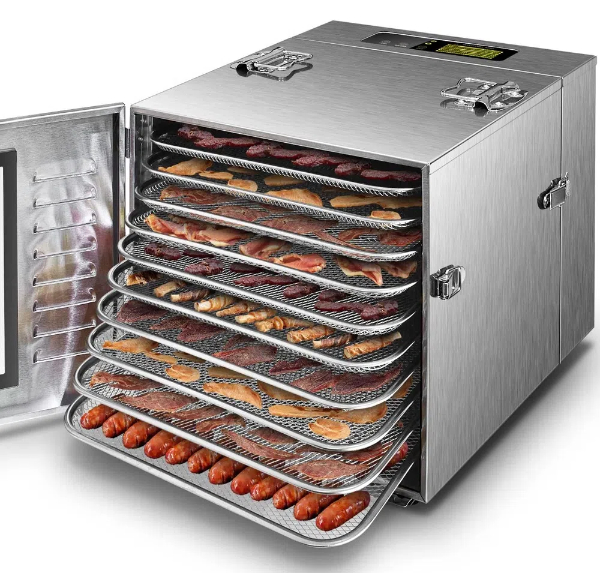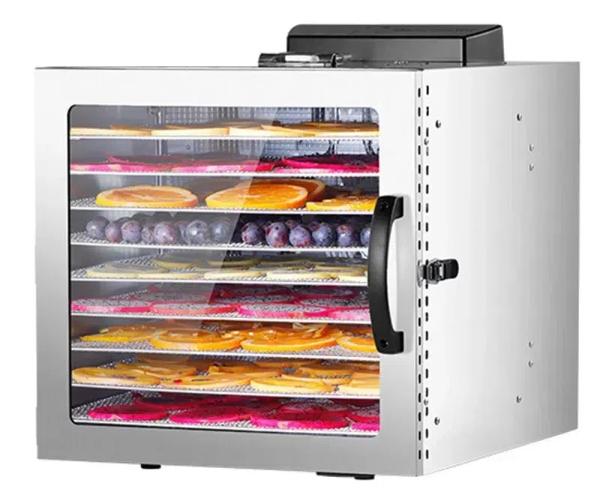
Content Menu
● Introduction
● Understanding Cabinet Type Dehydrators
>> Key Features and Benefits
● Factors Affecting Dehydration Efficiency
>> 1. Food Preparation
>> 2. Loading the Dehydrator
>> 3. Temperature and Humidity Control
>> 4. Airflow
>> 5. Dehydrator Maintenance
● Optimizing Your Cabinet Type Dehydrator for Efficiency
>> 1. Energy-Efficient Practices
>> 2. Food Arrangement Techniques
>> 3. Leveraging Technology
>> 4. Preventative Maintenance
● Advanced Techniques for Specific Foods
>> Dehydrating Fruits
>> Dehydrating Vegetables
>> Dehydrating Meats
>> Dehydrating Herbs
● Troubleshooting Common Issues
>> Uneven Drying
>> Slow Drying
>> Food Scorching
● Case Studies and Examples
>> Small-Scale Farm
>> Commercial Food Processor
>> Research Findings
● The Future of Cabinet Dehydration Technology
>> Emerging Trends
● Conclusion
● FAQ
>> 1. What is a cabinet type dehydrator?
>> 2. What are the benefits of using a cabinet dehydrator?
>> 3. How can I improve the energy efficiency of my cabinet dehydrator?
>> 4. What types of food can I dehydrate in a cabinet dehydrator?
>> 5. How often should I clean and maintain my cabinet dehydrator?
● Citations:
Introduction
As a leading Chinese food dehydrator OEM factory, we understand the critical importance of maximizing efficiency with your cabinet type dehydrator. These machines are essential for preserving food, extending shelf life, and creating a variety of healthy snacks and ingredients. This comprehensive guide provides in-depth knowledge and practical tips to optimize the performance of your cabinet dehydrator, reduce energy consumption, and ensure consistent, high-quality results. Whether you're a seasoned food processor or new to the world of dehydration, this article will help you unlock the full potential of your equipment.

Understanding Cabinet Type Dehydrators
A cabinet type dehydrator, also known as a shelf-style dehydrator, is a self-contained unit designed to remove moisture from food products. These machines are characterized by their integrated design, which combines a heat pump dryer with a precisely controlled chamber to optimize performance and maximize energy efficiency. Unlike simpler dehydrators, cabinet models offer unparalleled consistency and control, making them a preferred choice for commercial applications and serious home users.
Key Features and Benefits
-Integrated Design: The seamless integration of the heat pump dryer with the chamber optimizes performance and energy utilization. This design minimizes heat loss and maximizes airflow efficiency, ensuring uniform drying across all trays.
-Precise Control: Cabinet dehydrators offer precise temperature and airflow control, ensuring even dehydration and preserving the integrity of textures and flavors. Accurate temperature settings are crucial for preventing scorching or under-drying of food products.
-Large Capacity: Suitable for processing significant quantities of food, making it ideal for commercial operations. They can handle batches ranging from 100kg to 1000kg of products. This large capacity allows businesses to efficiently process bulk quantities of produce, reducing labor costs and increasing throughput.
-Versatility: Can be used for various types of food products, from fruits and vegetables to meats and herbs, flowers, noodles and pasta. Adjustable settings allow for optimized dehydration of different materials.
-Energy Efficiency: Optimizes energy use by integrating a heat pump dryer and minimizing heat loss through insulation. Modern cabinet dehydrators often feature insulated walls and doors to minimize heat loss.
-Extended Shelf Life: By effectively removing moisture, cabinet dehydrators significantly increase the shelf life of food products. Proper dehydration can extend the shelf life of food by months or even years, reducing spoilage and waste.
-Nutrient Preservation: Cabinet dehydrators excel at preserving the natural flavors, colors, and nutrients in food. The precisely controlled drying process minimizes nutrient degradation, resulting in healthier and more flavorful products.
-Waste Reduction: Cabinet dehydrators help farmers and producers convert seasonal harvests into all-season products, minimizing food waste.
-Hygienic Environment: The enclosed design of the cabinet dehydrator minimizes contamination from dust, insects, and other environmental factors, providing a hygienic environment for food processing.
Factors Affecting Dehydration Efficiency
Several factors can impact the efficiency of your cabinet type dehydrator. Understanding these factors is crucial for optimizing performance and minimizing waste.
1. Food Preparation
Proper food preparation is essential for efficient dehydration.
-Slicing and Dicing: Cut food into uniform sizes and shapes to ensure even drying. Thinner slices dehydrate faster. For instance, apple slices should be about ¼ inch thick for optimal drying.
-Blanching: Blanching vegetables before dehydration can help preserve color and nutrients. Blanching involves briefly immersing vegetables in boiling water or steam, which inactivates enzymes that can cause discoloration and nutrient loss.
-Pre-Treatment: Some fruits benefit from pre-treatment with lemon juice or ascorbic acid to prevent browning. This is especially important for fruits like apples, bananas, and peaches, which are prone to oxidation.

2. Loading the Dehydrator
How you load your cabinet type dehydrator can significantly affect its efficiency.
-Single Layer: Arrange food in a single layer on each tray to allow for optimal airflow. Overlapping food pieces can restrict airflow and lead to uneven drying.
-Spacing: Leave space between pieces of food to promote even drying. Proper spacing allows air to circulate freely around each piece of food, ensuring uniform moisture removal.
-Avoid Overloading: Overloading the dehydrator can restrict airflow and lead to uneven drying. Always adhere to the manufacturer's recommended load capacity for optimal performance.
-Tray Material Matters: Trays made of stainless steel or food-grade plastic with wide mesh openings promote better air circulation than solid trays.
3. Temperature and Humidity Control
Maintaining precise temperature and humidity levels is critical for efficient dehydration.
-Temperature Settings: Use the correct temperature for the type of food you are dehydrating. Different foods require different temperature settings to prevent scorching or under-drying. Generally, fruits dehydrate best at lower temperatures (130-140°F), while meats require higher temperatures (155-160°F) to ensure food safety.
-Humidity Monitoring: Monitor the humidity levels inside the dehydrator to ensure proper drying conditions. High humidity levels can slow down the drying process, while low humidity levels can cause food to dry too quickly.
-Ventilation: Ensure proper ventilation to remove moisture-laden air from the dehydrator. Adequate ventilation is essential for maintaining optimal drying conditions.
4. Airflow
Proper airflow is essential for removing moisture from the food.
-Fan Functionality: Check that the fan is working correctly and circulating air evenly throughout the cabinet. A malfunctioning fan can lead to uneven drying and increased energy consumption.
-Air Filter Maintenance: Clean or replace air filters regularly to maintain optimal airflow. Clogged air filters can restrict airflow and reduce the dehydrator's efficiency.
-Obstructions: Ensure that there are no obstructions blocking the airflow inside the dehydrator. Obstructions can disrupt airflow and lead to uneven drying.
-Airflow Direction: In some models, the airflow direction can be adjusted. Experiment with different airflow directions to find the setting that provides the most even drying for your specific food product.
5. Dehydrator Maintenance
Regular maintenance is crucial for keeping your cabinet type dehydrator running efficiently.
-Cleaning: Clean the dehydrator after each use to prevent buildup and maintain hygiene. Food residue can harbor bacteria and affect the taste of subsequent batches.
-Inspections: Regularly inspect the dehydrator for any signs of wear and tear. Check for loose connections, damaged wires, and other potential issues.
-Component Replacement: Replace worn or damaged components promptly to prevent performance issues. This includes the heating element, fan motor, and control panel.
-Seal Integrity: Check the door seal regularly. A damaged seal can allow warm, moist air to escape, reducing efficiency and prolonging drying times.
Optimizing Your Cabinet Type Dehydrator for Efficiency
Here are some practical strategies to maximize efficiency with your cabinet type dehydrator:
1. Energy-Efficient Practices
-Batch Processing: Process multiple batches to minimize dehydrator heating and save electricity and time. It takes energy to get the dehydrator up to temperature, so running consecutive batches maximizes this initial energy input.
-Full Loads: Operate the dehydrator with full loads whenever possible to maximize energy efficiency. A fully loaded dehydrator utilizes the available space and energy more efficiently than a partially loaded one.
-Strategic Timing: Use the dehydrator during off-peak hours to take advantage of lower electricity rates. Many utility companies offer lower electricity rates during off-peak hours, typically at night.
-Lowering Temperature: Tweak the heat as you go; start higher and then lower it for the end.
-Timer: Use a timer feature to avoid overdoing and wasting energy.
-Insulation: If possible, place the dehydrator in a well-insulated area to minimize heat loss. This can help reduce energy consumption and improve efficiency.
2. Food Arrangement Techniques
-Consistent Temperature: Group similar food items while loading the trays. This ensures a consistent temperature for the whole batch, making things efficient.
-Uniformity: Dehydrate your goodies uniformly after preparing them. It'll ensure you dry up the food evenly and reduce excessive energy usage.
-Rotation: Rotate trays periodically to ensure even drying. Trays near the top or bottom of the dehydrator may dry faster than those in the middle, so rotating them ensures uniform drying.
-Food Type Grouping: Certain foods might produce different odors during dehydration. Separating foods with strong aromas from those with milder flavors prevents cross-contamination.
3. Leveraging Technology
-Smart Controls: Utilize advanced models with precise control over temperature and humidity. Some models even offer pre-programmed settings for different types of food.
-Remote Monitoring: Implement remote monitoring systems to track the dehydrator's performance in real-time. This allows you to monitor the dehydrator's temperature, humidity, and energy consumption from a remote location.
-Data Analysis: Analyze data to identify areas for improvement and optimize the drying process. Data analysis can reveal patterns and trends that can help you fine-tune your dehydration process for optimal efficiency.
-Automated Humidity Control: Some advanced models automatically adjust ventilation based on humidity levels inside the cabinet.
4. Preventative Maintenance
-Scheduled Cleaning: Establish a regular cleaning schedule to prevent buildup and maintain hygiene.
-Component Checks: Conduct routine checks of all components, including the heating element, fan, and control systems.
-Professional Servicing: Schedule professional servicing at regular intervals to ensure optimal performance.
-Calibration: Periodically calibrate the temperature sensors to ensure accurate readings. Inaccurate temperature readings can lead to under-drying or over-drying of food.
-Record Keeping: Maintain a logbook to record maintenance activities, repairs, and any performance issues.
Advanced Techniques for Specific Foods
Dehydrating Fruits
-Apples: Pretreat with lemon juice to prevent browning. Dehydrate at 135°F (57°C) for 6-12 hours.
-Bananas: Slice thinly and dehydrate at 135°F (57°C) for 6-10 hours.
-Grapes: Blanch briefly in boiling water before dehydrating at 135°F (57°C) for 24-36 hours to make raisins.
Dehydrating Vegetables
-Tomatoes: Slice thinly and dehydrate at 135°F (57°C) for 8-12 hours.
-Mushrooms: Slice thinly and dehydrate at 125°F (52°C) for 8-12 hours.
-Onions: Slice thinly and dehydrate at 125°F (52°C) for 6-10 hours.
Dehydrating Meats
-Beef Jerky: Marinate thinly sliced beef and dehydrate at 160°F (71°C) for 4-6 hours.
-Poultry: Cook poultry before dehydrating to ensure food safety. Dehydrate at 160°F (71°C) for 4-6 hours.
Dehydrating Herbs
-Basil: Dehydrate at 95°F (35°C) for 2-4 hours.
-Mint: Dehydrate at 95°F (35°C) for 2-4 hours.
-Rosemary: Dehydrate at 95°F (35°C) for 2-4 hours.
Troubleshooting Common Issues
Uneven Drying
-Cause: Overloading, improper spacing, or a malfunctioning fan.
-Solution: Reduce the load, ensure proper spacing, and check the fan.
Slow Drying
-Cause: High humidity, low temperature, or a clogged air filter.
-Solution: Increase the temperature, improve ventilation, and clean or replace the air filter.
Food Scorching
-Cause: Too high a temperature or uneven airflow.
-Solution: Lower the temperature and ensure proper airflow.
Case Studies and Examples
Small-Scale Farm
A small-scale farm uses a cabinet dehydrator to dry surplus fruits and vegetables, which are then sold at local farmers' markets. This allows the farm to reduce waste and generate additional revenue. The dehydrator helps the farm diversify its product offerings and extend its selling season.
Commercial Food Processor
A commercial food processor uses a large-scale cabinet dehydrator to produce dried meat snacks for retail sale. The dehydrator allows the processor to maintain consistent product quality and meet the demands of a growing market. The processor can also customize the drying process to create unique flavors and textures.
Research Findings
-Study 1: A cabinet fruit and vegetable dehydrator was designed to reduce moisture content and extend shelf life. The machine achieved average dehydrating capacities of 81.33 g/hr for banana, 113.67 g/hr for mango, 44 g/hr for chili pepper, and 53.33 g/hr for carrots. This study highlights the efficiency of cabinet dehydrators in preserving a variety of fruits and vegetables.
-Study 2: Another study focused on a food processing drying device that included a cabinet with an insulation layer, heating components, and a temperature and humidity controller. The device improved drying efficiency and reduced energy consumption. This study underscores the importance of insulation and precise control systems in maximizing the performance of cabinet dehydrators.
The Future of Cabinet Dehydration Technology
The field of cabinet dehydrator technology is constantly evolving, with new innovations and trends emerging to improve efficiency, performance, and versatility.
Emerging Trends
-Smart Dehydrators: Integration of IoT (Internet of Things) technology for remote monitoring and control. This allows users to monitor and control the dehydrator from their smartphones or other devices.
-AI-Powered Optimization: Use of artificial intelligence to optimize drying parameters based on real-time data. AI algorithms can analyze data on temperature, humidity, and food moisture content to automatically adjust the drying process for optimal efficiency and quality.
-Sustainable Practices: Focus on energy-efficient designs and environmentally friendly materials. This includes using recycled materials, reducing energy consumption, and minimizing waste.
-Heat Pump Technology: Integration of heat pump systems for even greater energy savings. Heat pumps recycle heat within the system, significantly reducing energy consumption.
-Advanced Materials: Use of advanced materials like graphene for more efficient heat transfer and improved insulation.
Conclusion
Maximizing efficiency with your cabinet type dehydrator is essential for achieving optimal performance, reducing costs, and ensuring high-quality results. By understanding the key features of cabinet dehydrators, implementing energy-efficient practices, and leveraging the latest technology, you can unlock the full potential of your equipment. As a leading Chinese food dehydrator OEM factory, we are committed to providing you with the knowledge and resources you need to succeed in the competitive food processing industry.

FAQ
1. What is a cabinet type dehydrator?
A cabinet type dehydrator is a self-contained unit designed to remove moisture from food products, extending their shelf life while preserving their natural flavors and nutrients. These machines feature an integrated design with a heat pump dryer and a controlled chamber, ensuring consistent and efficient drying.
2. What are the benefits of using a cabinet dehydrator?
Cabinet dehydrators offer several benefits, including precise control over temperature and airflow, large capacity for commercial operations, versatility for various food types, energy efficiency, extended shelf life, nutrient preservation, waste reduction, and a hygienic processing environment.
3. How can I improve the energy efficiency of my cabinet dehydrator?
To improve energy efficiency, consider batch processing, operating with full loads, using strategic timing during off-peak hours, adjusting temperature settings, and ensuring proper maintenance. Additionally, placing the dehydrator in a well-insulated area can help reduce energy consumption.
4. What types of food can I dehydrate in a cabinet dehydrator?
Cabinet dehydrators are versatile and can be used for a wide range of food products, including fruits, vegetables, meats, herbs, flowers, noodles, and pasta. Different foods require different temperature and humidity settings, so it's essential to consult the manufacturer's instructions or a reliable dehydration guide.
5. How often should I clean and maintain my cabinet dehydrator?
You should clean your cabinet dehydrator after each use to prevent buildup and maintain hygiene. Regularly inspect the dehydrator for any signs of wear and tear, and schedule professional servicing at regular intervals to ensure optimal performance. This includes checking the heating element, fan motor, and control panel.
Citations:
[1] https://www.dryeratech.com/the-ultimate-guide-to-cabinet-type-dehydrator-machines.html
[2] https://www.dryeratech.com/the-science-behind-cabinet-type-dehydrators.html
[3] https://patents.google.com/patent/CN110207480A/zh
[4] https://www.dryeratech.com/top-10-benefits-of-using-a-cabinet-type-dehydrator.html
[5] https://www.vevor.com/diy-ideas/do-dehydrators-use-a-lot-of-electricity/
[6] https://patents.google.com/patent/CN201919616U/zh
[7] https://repository.cpu.edu.ph/handle/20.500.12852/1187
[8] https://www.dehydratorfactory.com/Company-News/630.html











